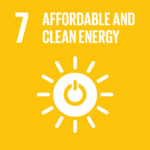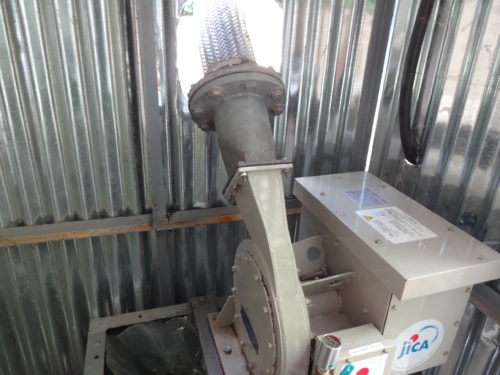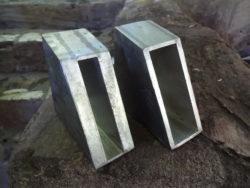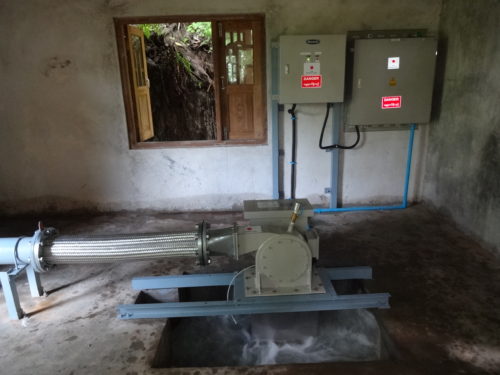KITA Method for Sustainable

and Efficient Power Generation
ITKA MACHINERY offers engineering design and installation method of the whole micro hydropower system. Our micro hydropower system is providing not only excellent machines, but also the know-how in understanding the site conditions, selection of equipment and parts, design and installation method. Based on the know-how, we can make an optimal suggestion for local needs and conditions. We have delivered the system in four countries including Japan so far, and we have experience of making proposals corresponding to each site situation. We can also offer to procure parts locally as much as possible. We introduce equipment that can be operated with less maintenance, which can help to be operated by local people, and there is very low operating cost after installation.
We believe that local production for local consumption of energy is environmentally friendly. In particular, installation of renewable energy system in areas where there is no grid or limited energy consumption is effective for reducing energy loss. Micro hydropower is especially stable and can be used as a base load power source for solar power and wind power.
Our system is not a packaged product but designed for each site, and provide stable power. We have own method such as securing high water pressure for efficient power generation and environmentally friendly construction. We aim to build a continuous partnership with local people and to enable local people to install, operate and manage micro hydropower system through the training.
We believe that we can contribute to sustainable local development with our technology.

Fig. 1 Hydopower unit installed by KITA MACHINERY (joint project with JICA)
Major Features and Advantages
・Stable Power Supply
Our system enable continuous power generation as long as necessary water flow rate and pressure are available. As we design facilities based on the minimum flow rate in the dry season, it is easy to maintain the required minimum output.
Even if there are fluctuations in power load, flow rate or water pressure, stable output of voltage and frequency can be obtained.
By training our technology of design, construction and installation methods, local people will be able to continuously install, operate and manage.
・Water control
Our technology controls the flow of water so that pressure is efficiently applied to the turbine part, by installing a nozzle at the inlet of the turbine (see Fig. 2) or/and adjusting the air pressure in the draft tube with an air valve (see Fig. 3).This makes it possible to maintain the minimum effective head even during drought periods.


Fig. 2 Inlet nozzle Fig. 3 Air valve
Table 1 shows that the maximum electric power can be increased by 0.29MPa by inserting the inlet nozzle, while the water flow rate is 70~75m3/hr.

・Easy Maintenance
Design without dummy load (virtual loads), which is a maintenance issue of small hydropower, leads to reduce the number of failures. Maintenance is basically only replacement of bearing every 5 years and daily easy cleaning around the micro hydropower.
・Base load power source
If considering the use of renewable energy such as solar and wind power, and its location is suitable for hydropower, hydropower is available to use as a baseload power source.
・Local Development
Once local people learn KITA method through the training, they will be able to design, procure, construct and install by themselves. Equipment and parts will be procured locally as much as possible, so it may lead to the local industrial development.
・Energy by local production for local consumption
This technology can be conversion to energy from local resource. Reduction of energy loss during power transmission can reduce environmental load at the time of energy creation by local production for local consumption.
Technology Data
Possible applications
We believe that our design and installation technology of the micro hydropower is to empower the local people in the following applications.
○ Enable unelectrified areas to electrify
– Children can study at night
– People can work at night
– People can charge mobile phones at home
○ It can be used as a stable power source in areas with unstable power conditions
○ Enable to generate electricity without emitting CO2
○ It can be used as a power source for mobile phone relay stations
○ Promotion of local industry and community management
Our design concept is that operation can be done by local people. We believe that local people will be able to continuously install, operate and manage the micro hydropower system on their own through our assistance and training.
Competitive advantage
Our micro hydropower system is not only providing excellent machines, but also the know-how in understanding the site conditions, selection of equipment and parts, design and installation method. Based on the know-how we can make an optimal suggestion for local needs and conditions.
・Low Operation Cost
The operation cost is very low because power is not required at the time of introduction and after introduction other than civil engineering work, and continuous power generation is possible as long as there is the necessary flow rate and pressure.
Furthermore, with regard to the initial cost, equipment and parts will be procured locally as much as possible, so it leads to cheaper initial cost compared to transport all equipment from Japan.
・Eco Friendly Construction
As we propose design and construction that have environmental impact as small as possible, it is possible to install micro hydropower only with small-scale engineering works.
・Know-how at site
We select installation sites in consideration of the ground, geology and geography history conditions and past disasters. And we install a micro hydropower in places which are not affected by climate change, natural disasters, etc. as much as possible.
・Saving Resources & Less Maintenance
As we design compact and easy maintenance, the number of parts can be reduced. Periodic replacement parts are only bearings. By design without dummy load (virtual load), which is a maintenance issue of small hydropower leads to reduce the number of failures.
・Low Carbon Emission of transportation
Parts will be procured locally as much as possible, so there will be no CO2 emissions from transportation from Japan.
・Reuse
Local second-hand parts: Pipe (steel, stainless) etc. can also be reused.
Performance
Capacity: 1.0~5.0 kW
Effective Head: 10~30m (0.24 MPa water pressure at the end of penstock before into the turbine)
Flow rate: 0.02~0.04㎥/s (20~40L/sec)
Frequency: 50/60Hz
Voltage: AC 202V or 100V
Energy conversion efficiency: Approx. 40~53%
Water turbine: cross flow type
Occupancy rate: Approx. 96%
Annual energy production: Approx. 42,000kW (exclude approx. a day in a month for maintenance)
Technical maturity / Past record of introduction
【Domestic】
・Case in Tokushima, Japan in 2011
Installed one unit as a pilot project of Ministry of Internal Affairs and Communications.
※Due to the end of the project, it was removed.
 Fig. 4 Hydropower unit in Japan (cross flow type)
Fig. 4 Hydropower unit in Japan (cross flow type)
【Overseas】
・Case in the Philippines, in 2015
Installed one unit for tourism promotion and power supply for water treatment system to treat water from waterfall.
 Fig. 5 Hydropower unit in the Philippines (cross flow type)
Fig. 5 Hydropower unit in the Philippines (cross flow type)
※It has been stand-by, because the operation and maintenance work has not been handed over to the person in charge when policy of the municipal government was changed.
Pilot Survey Summary Report (Philippines)
・Case in Myanmar in 2016
Installed 5 units in the villages without electricity for the purpose of supplying household power (in operation).
 Fig. 6 Hydropower unit in Myanmar (cross flow type)
Fig. 6 Hydropower unit in Myanmar (cross flow type)
・Case in El Salvador in 2018
Installed 4 units in national universities as experimental equipment. (in operation).
 Fig. 7 Hydropower unit as experimental equipment in El Salvador (cross flow type)
Fig. 7 Hydropower unit as experimental equipment in El Salvador (cross flow type)
Information on patent related to this technology
Flow adjustment nozzle for water turbine of hydropower
Patent No. 5916640 (JP)
Company Data
| Name | KITA MACHINERY Co.,Ltd |
| Address | Shomachi 3-16, Tokushima-shi, Tokushima, 770-0044 JAPAN |
| Capital | 10 million JPY (as of 31 January, 2019) |
| Contact person |
Environmental Business Div. |
| Number of employees | 241 (as of June 1, 2019) |
| Date of company foundation | April 13, 1961 |
| The type of business |
・Engineering design, procurement, installation of water treatment system and micro hydropower system |
International operation
| Number of employees for international operation |
10 |
|
| Overseas offices |
City, Country | Name of Company (if applicable) |
| N/A | N/A | |
Modality of business transaction
Direct investment
If we can find a good technology or partner in the local, we would like to invest them directly and would like the partner to join our business.
Partnership
At first, we would like to export the product and let the local partner maintain it. In the future, we also would like to let the partner assembly the products on site.
Attachments
Contact Person(s)
*Please mention that you saw UNIDO's website when making the first contact with the company.
Registered Category
- Energy Technologies : Renewable energy


